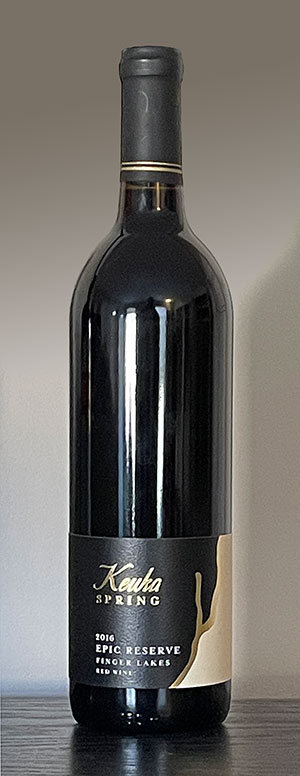 Keuka Spring Epic Reserve Finger Lakes Red Wine 2016
Keuka Spring Epic Reserve Finger Lakes Red Wine 2016
Long before California became America’s leading winemaking state, plenty of wine was being made in New York. The Hugeunots, a French Protestant sect of the 16th and 17th centuries, planted grapevines there in the 1600s. The first commercial plantings of native American grape varieties began in 1862. Shortly thereafter, the area established a reputation for making sweet sparkling wines, and by the end of the 19th century plantings had increased to around 25,000 acres.
In the early 20th century, production declined sharply as a result of phylloxera vine disease, competition from California wines, and Prohibition. After that scourge ended, production resumed but the rebound was moderate. Further limiting production, after World War II Americans began to develop a taste for the drier wines made from the European Vitis vinifera grape varieties dominant in California. Unlike in California, however, it was believed that these grape varieties would not survive in the harsh New York winters.
In 1951 Dr. Konstantin Frank, a Ukrainian immigrant with a PhD degree in Plant Science, came to work at the New York State Agricultural Experiment Station in Geneva, New York, with the goal of growing Vitis vinifera varietals in the cold Finger Lakes climate. This was unheard of — and laughed at — back then. Other winemakers predicted failure. “What do you mean?” Frank retorted. “I’m from Russia — it’s even colder there.” With support from Charles Fournier of Gold Seal Vineyards, a sparkling wine producer, he began planting Vitis vinifera vines in 1958. In 1962 Dr. Frank started Vinifera Wine Cellars in Hammondsport, at the far southern end of Keuka lake, where he began to successfully produce Riesling, Pinot Noir, Chardonnay, Gewürtztraminer, Cabernet Sauvignon, and Rkatsiteli (the most widely-planted white-wine grape in the countries of the former Soviet Union). Plantings of these varieties spread throughout the region and new wineries soon emerged. Continue reading “Keuka Spring Epic Reserve”
